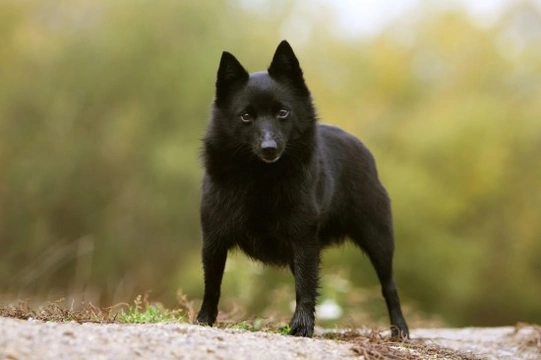
Schipperke dog hereditary health and longevity
The schipperke is a Dutch dog breed that is classed as a small sheepdog, and also falls within the spitz dog grouping. They are a small breed, with males standing up to 13.2” tall at the withers and weighing between 7-20lb, with females being slightly smaller. They have small, pointed ears, curled tails, and a compact build with a double layered coat that is typical of most spitz dog breeds. The coat is thick and profuse, with a dense undercoat and longer top coat, which sheds heavily all year round. As well as their general shedding, the breed will blow their coat twice a year too, losing a lot of their general hair and bulk within a short period of time.
They are black in colour and are sometimes referred to as “the little black fox,” which is a good description of their general appearance and shape. They are alert, lively little dogs that are still used within working roles in some areas of Holland, and as such, are very active and need plenty of exercise to stay fit and healthy.
If you are wondering if the schipperke is the right choice of dog for you, you will need to do plenty of research into the breed as a whole before making your final decision. Part of this should include finding out as much as possible about the longevity, general health and any known health problems within the breed, which we will look at in more detail within this article.
Schipperke longevity
The average lifespan of the schipperke is 13-15 years, which places the breed above the average across the board for all dog breeds of a similar size and build. This indicates that the schipperke breed as a whole has a tendency to good health, and that they are generally considered to be robust, hardy and fit little dogs.
Genetic diversity
The coefficient of inbreeding statistic for the schipperke is 9.6%, which is rather higher than the accepted figure of 6.25% or lower that is the ideal for pedigree dog breeds. This indicates that the breed is subjected to a reasonable amount of inbreeding in order to keep the breed viable, although this has not proven cause for concern for the breed as a whole as yet. However, inbreeding can lead to issues including a greater incidence of hereditary health issues, smaller litter sizes, and increased foetal mortality rates, and so schipperke breeders are advised to reduce the coefficient of inbreeding statistic within their own breed lines where possible.
Conformation
The shape and build of the schipperke is compact, muscular and in proportion, and generally considered to be fit for life and not likely to pose any specific problems. While their coats are thick and dense, they are not as thick as those of dogs that are native to the coldest countries, and so rarely pose a problem in hot weather providing that the dog has ample opportunities to keep cool.
A reasonable amount of brushing, grooming and maintenance is required to keep the schipperke coat in good condition.
Health testing for the schipperke
The schipperke can fairly be described as one of the most robust and generally hardy of all pedigree dog breeds, and as such, they are not plagued with a wide range of hereditary health conditions that can be passed onto the next generation. However, a couple of known hereditary issues are present across the breed, and as such, The Kennel Club and the British Veterinary Association recommends pre-breeding health screening for two hereditary health conditions:
- Progressive retinal atrophy, a progressive eye condition that leads to irreversible blindness.
- Mucopolysaccharidosis MPS111B, a metabolic disorder that leads to a type of storage disease and general loss of condition.
Other health issues
As mentioned, the general health of dogs of the schipperke breed is considered to be good, and they are not one of the breeds that boasts a list as long as your arm of potential health conditions known to present within dogs of the breed. However, there are a few conditions that affect the schipperke breed with a slightly higher occurrence rate than that of other breeds, including:
- Epilepsy, which may have a hereditary element to it. Epileptic dogs should not be bred from, but with medication, can usually lead relatively normal lives.
- Hypothyroidism, or an underactivity of the thyroid gland. This can lead to weight gain and lethargy, and may require hormone therapy to manage the condition.
- Patellar luxation, a condition of the kneecaps that causes them to slip or dislocate, and may require surgical correction.
- Cataracts of the eyes, although these are usually operable in order to preserve the dog’s vision.
- Legg-Calve-Perthes disease, a condition of the hip joint caused by the degeneration of the head of the femur. This leads to severe pain and chronic lameness.



